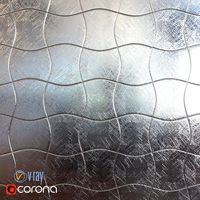Thingiverse

Gravitational Waves - The first 6 detections by Almoturg
by Thingiverse
Last crawled date: 3 years, 1 month ago
On the 14th of September 2015 the twin detectors of the Laser Interferometer Gravitational-Wave Observatory (LIGO) made the first direct observation of gravitational waves. According to Einstein's theory of general relativity, when massive objects are accelerated they emit gravitational waves – ripples in spacetime that spread at the speed of light.
And when the objects are several times as massive as our sun, and move at extremely high speeds, they are strong enough that we have a chance to detect them. Mergers of black holes and of neutron stars provide exactly the right conditions for the emission of strong gravitational waves.
The source of the first detected signal, named GW150914, was the collision and merger of two black holes in a distant galaxy, 440 megaparsec (=1435000000 light years) from earth. The masses of the two black holes were about 35 and 30 times that of the sun. The resulting black hole had a mass of only 62 solar masses, with the difference, 3 solar masses (!!), being emitted as gravitational waves.
Gravitational waves are moving distortions of spacetime itself. When they pass through objects which are not rigidly bound together, such as a ring of masses floating in space (or the suspended test masses in the LIGO detectors), they change the distance between them.
Imagine a ring of masses freely floating around the earth. When a gravitational wave passes through it distorts the ring, stretching it in one direction and compressing it in the other. The distortion rotates with the same frequency as the black holes that created the gravitational wave orbited each other. As the black holes get closer together they orbit faster and faster, and the gravitational waves, and therefore the distortion of our ring of masses gets stronger.
The models here show the time evolution of this distortion during the last one tenth of a second before the black holes merge. Each horizontal slice corresponds to one instant of time. The distortion is calculated for rings at the location of the earth and shown exaggerated by a factor of 5×10^20, that is 500000000000000000000! In reality the effect is absolutely minuscule, changing the length of the 4km (=2.5 miles) LIGO detectors by less than the diameter of a proton. (Here is a video giving a glimpse into how the LIGO detectors can measure such tiny variations in distance.)
There are 6 models, one for each gravitational wave signal detected until now. In the first image above you can see the sources for each of the signals, the size of the circles corresponds to the size (and therefore mass) of the objects.
The first 5 come from collisions of black holes. The amplitude of the signal depends on both the masses of the black holes, their distance from earth, and their orientation. The frequency of the signal depends on the mass of the black holes, with the first one, GW150914 being the heaviest and GW170608 the lightest.
The source of the last signal, GW170817, was the merger of two neutron stars, which (probably) formed a black hole. As neutron stars are a lot lighter than black holes the frequency is very high. The strength of the emitted gravitational waves was a lot lower than that of the black hole mergers, but here the source was more than 10 times closer than that of GW150914.
All the models are at the same scale, both in time (10.8 millisecond per centimeter) and amplitude (5×10^20 times the actual effect size), so you can compare the different types of signals.
You can see how the frequency and amplitude of the signal rises as the two black holes spiral closer and closer to each other (this is called the inspiral phase), then the instant at which they merge, and finally the ringdown where the amplitude decays exponentially as the newly formed single black hole wobbles until it settles down to its final shape.
And when the objects are several times as massive as our sun, and move at extremely high speeds, they are strong enough that we have a chance to detect them. Mergers of black holes and of neutron stars provide exactly the right conditions for the emission of strong gravitational waves.
The source of the first detected signal, named GW150914, was the collision and merger of two black holes in a distant galaxy, 440 megaparsec (=1435000000 light years) from earth. The masses of the two black holes were about 35 and 30 times that of the sun. The resulting black hole had a mass of only 62 solar masses, with the difference, 3 solar masses (!!), being emitted as gravitational waves.
Gravitational waves are moving distortions of spacetime itself. When they pass through objects which are not rigidly bound together, such as a ring of masses floating in space (or the suspended test masses in the LIGO detectors), they change the distance between them.
Imagine a ring of masses freely floating around the earth. When a gravitational wave passes through it distorts the ring, stretching it in one direction and compressing it in the other. The distortion rotates with the same frequency as the black holes that created the gravitational wave orbited each other. As the black holes get closer together they orbit faster and faster, and the gravitational waves, and therefore the distortion of our ring of masses gets stronger.
The models here show the time evolution of this distortion during the last one tenth of a second before the black holes merge. Each horizontal slice corresponds to one instant of time. The distortion is calculated for rings at the location of the earth and shown exaggerated by a factor of 5×10^20, that is 500000000000000000000! In reality the effect is absolutely minuscule, changing the length of the 4km (=2.5 miles) LIGO detectors by less than the diameter of a proton. (Here is a video giving a glimpse into how the LIGO detectors can measure such tiny variations in distance.)
There are 6 models, one for each gravitational wave signal detected until now. In the first image above you can see the sources for each of the signals, the size of the circles corresponds to the size (and therefore mass) of the objects.
The first 5 come from collisions of black holes. The amplitude of the signal depends on both the masses of the black holes, their distance from earth, and their orientation. The frequency of the signal depends on the mass of the black holes, with the first one, GW150914 being the heaviest and GW170608 the lightest.
The source of the last signal, GW170817, was the merger of two neutron stars, which (probably) formed a black hole. As neutron stars are a lot lighter than black holes the frequency is very high. The strength of the emitted gravitational waves was a lot lower than that of the black hole mergers, but here the source was more than 10 times closer than that of GW150914.
All the models are at the same scale, both in time (10.8 millisecond per centimeter) and amplitude (5×10^20 times the actual effect size), so you can compare the different types of signals.
You can see how the frequency and amplitude of the signal rises as the two black holes spiral closer and closer to each other (this is called the inspiral phase), then the instant at which they merge, and finally the ringdown where the amplitude decays exponentially as the newly formed single black hole wobbles until it settles down to its final shape.
Similar models
thingiverse
free

GW150914 by dawnerb
...tational wave signature (the strength of the wave vs time) of two merging black holes, as seen by ligo's livingston detector.
thingiverse
free

Binary Inspiral by dawnerb
...t before merging, with the spiral representing the gravitational waves. the model includes a small loop for attaching to a chain.
thingiverse
free

Gravity Wave Spectrogram by lnemzer
...f the high-frequency components as the black holes spiral together faster and faster. from https://losc.ligo.org/events/gw150914/
thingiverse
free

HLV cones by thetfoot
...onding cone where the source might lie. the intersection of the three cones (gray bar) is the direction of the source in the sky.
thingiverse
free

GW150914, gravitational wave by VirgoOutreach
...a nucleare (infn), padova, italy & virgo collaboration
visit our web sites: https://www.virgo-gw.eu and https://www.ego-gw.it
cg_trader
$425

gravitational waves
...gravitational waves
cg trader
gravitational waves gravitational wave astronomy ligo virgo space other
thingiverse
free

Binary Neutron Star Merger
...feedback is welcome.)
print status:
successful.
support: yes (but might be okay without)
adhesion: yes (might survive without it)
3dwarehouse
free

sun
...sun
3dwarehouse
using sandbox tools to represent gravitational space/time distortion #distortion #gully #sandbox #spacetime
cg_trader
$100

Acoustic Doppler effect with universal counter
...tion relative to the medium of propagation, the frequency of the waves that are emitted or detected is shifted due to the doppler
thingiverse
free

gravitational waves by MachineKing
...gravitational waves by machineking
thingiverse
trying to generate distortions in space-time using openscad
Almoturg
thingiverse
free

Twisted Spiral Vase by Almoturg
...twisted spiral vase by almoturg
thingiverse
inspired by https://www.thingiverse.com/thing:481259.
thingiverse
free

Twisted Platonic Solids by Almoturg
...iginal by robert reid).
at full scale they are around 6.5cm (2.6 inches) tall. the ones in the pictures are printed at 65% scale.
thingiverse
free

Gravitational Waves - in resin by kevfquinn
...all the information about what these are. thanks to almoturg for an interesting set of models! additional - see...
Gravitational
turbosquid
$25

BLAME! Gravitational beam emitter
...el blame! gravitational beam emitter for download as and dae on turbosquid: 3d models for games, architecture, videos. (1536111)
3d_export
$5

Trebuchet
...trebuchet 3dexport medieval gravitational throwing machine for the siege of...
3d_export
$5

ceiling light
...ceiling light 3dexport it is a gravitational balancing pattern.<br>this is a perfect combination of individual cables....
3d_export
$55

Affekta X-Fusion S1 Sci-Fi concept car BEST FUTURISTIC DESIGN
...usion s1 concept sci-fi car!<br>use to game, animation...<br>carbody only! : <br>i hope you like it ;) good buy
3d_export
$30

Affekta Futurex Sci-Fi BEST DESIGN Future Concept Cyberpunk
...lt;br>vr simulations<br>vr games<br>vr test<br>short animations<br>showreels<br>movie background
thingiverse
free

Anti-Gravitator by reparator
...lso called levitator or levitron. it lets a small magnet sphere levitate in a magnetic field.
video: https://youtu.be/0ftbobwkf2y
thingiverse
free

gravitational waves by MachineKing
...gravitational waves by machineking
thingiverse
trying to generate distortions in space-time using openscad
thingiverse
free

Gravitational Hook - 200% by Snorri
...(well you will need longer ones), i added a bit of tolerance the holes are actually 3.3mm, so everything should move more easily.
thingiverse
free

Gravitational potential well by elandahl
...and orbits_description.pdf) as well as the matlab code (orbits_3dprinting.m) used to generate this surface are available as well.
thingiverse
free

Gravitational hook by Snorri
... the hook in action made by this gentleman : http://www.thingiverse.com/creuzerm/abouthttps://www.youtube.com/watch?v=ofhqt22qkis
Detections
turbosquid
$99

Detective
... available on turbo squid, the world's leading provider of digital 3d models for visualization, films, television, and games.
turbosquid
$6

Noir Detective
...uid
royalty free 3d model noir detective for download as fbx on turbosquid: 3d models for games, architecture, videos. (1334585)
turbosquid
$7

Hat Detective
...ree 3d model hat detective for download as obj, fbx, and gltf on turbosquid: 3d models for games, architecture, videos. (1643999)
turbosquid
$39

Detective Character
... available on turbo squid, the world's leading provider of digital 3d models for visualization, films, television, and games.
3d_export
$146

detective karan
...
detective karan is a 3d model which you can use for your animations or in your 3d games so why are you waiting just get it fast!
3d_export
$50

Detective Holms 3D Model
...odel
3dexport
man figure human detective mystery male character rigged max
detective holms 3d model vanishingpoint 73358 3dexport
turbosquid
$25

Detection wire LG.max
... available on turbo squid, the world's leading provider of digital 3d models for visualization, films, television, and games.
3d_export
$10

cartoon detective office
...als, so you can easily import and configure the scene in another program. i hope these models will help you to realize your idea.
3d_export
$49

detective
...ith your projects. please let us know if you have any questions or need assistance. if you like our model please rate it! thanks!
3d_export
$31

game-ready detective rigged and animated
...y rigged and animated 3d model of a detective character. model can be used in games developments, films, cartoons and so on. this
Waves
3ddd
$1

Wave
...wave
3ddd
wave
wave
3ddd
free

Mobilidea Wave
...mobilidea wave
3ddd
mobilidea , wave
mobilidea wave
design_connected
$22

Wave
...wave
designconnected
royal botania wave computer generated 3d model. designed by nyberg, erik.
3ddd
$1

Elica Wave
... вытяжка , островная
вытяжка подвесная elica wave
3d_export
$5

sideboard wave
...sideboard wave
3dexport
sideboard wave kare design
turbosquid
$5

Waves
... available on turbo squid, the world's leading provider of digital 3d models for visualization, films, television, and games.
turbosquid
$3

Wave
... available on turbo squid, the world's leading provider of digital 3d models for visualization, films, television, and games.
turbosquid
free

Wave
... available on turbo squid, the world's leading provider of digital 3d models for visualization, films, television, and games.
3ddd
$1

Бра PANZERI WAVE
... wave , led , panzeri wave
бра panzeri wave
3ddd
$1

Wave armchair
...
wave , jihye choi
кресло wave armchair от jihye choi. сделано из сталя, дерева и ткани.
First
turbosquid
free

First
... available on turbo squid, the world's leading provider of digital 3d models for visualization, films, television, and games.
design_connected
$16

Chair First
...chair first
designconnected
magis chair first computer generated 3d model. designed by giovannoni, stefano.
design_connected
$13

Table First
...table first
designconnected
magis table first computer generated 3d model. designed by giovannoni, stefano.
turbosquid
$3

First Character
...squid
royalty free 3d model first character for download as on turbosquid: 3d models for games, architecture, videos. (1498951)
turbosquid
$39

Egg First
...
royalty free 3d model egg first for download as max and fbx on turbosquid: 3d models for games, architecture, videos. (1207383)
turbosquid
$20

First Win
...
royalty free 3d model first win for download as max and fbx on turbosquid: 3d models for games, architecture, videos. (1440117)
turbosquid
$39

Tour First
...ee 3d model tour first for download as 3ds, max, obj, and fbx on turbosquid: 3d models for games, architecture, videos. (1313928)
turbosquid
$3

first aid
... available on turbo squid, the world's leading provider of digital 3d models for visualization, films, television, and games.
turbosquid
$3

First Aid
... available on turbo squid, the world's leading provider of digital 3d models for visualization, films, television, and games.
turbosquid
free

First Aid
... available on turbo squid, the world's leading provider of digital 3d models for visualization, films, television, and games.
6
3d_export
$18

tulip 6
...tulip 6
3dexport
tulip 6
3d_export
$5

hinge 6
...hinge 6
3dexport
hinge 6
3ddd
$1

MASIERO / FLASHWOOD STL 6 + 6
...6
3ddd
masiero
торшер flashwood stl 6 + 6 фабрики masiero
http://www.masierogroup.com/c87_697/it/flashwood%20stl%206%20+%206.ashx
turbosquid
$110

Atmos Cannon 2000 6*6
...yalty free 3d model atmos cannon 2000 6*6 for download as skp on turbosquid: 3d models for games, architecture, videos. (1528591)
turbosquid
$1

ae 6 6 electric locomotive
... free 3d model ae 6 6 electric locomotive for download as obj on turbosquid: 3d models for games, architecture, videos. (1707537)
turbosquid
$39

A-6
... available on turbo squid, the world's leading provider of digital 3d models for visualization, films, television, and games.
3ddd
$1

6 ковров
...6 ковров
3ddd
ковры , ковер
6 ковров
turbosquid
$12

Calligraphic Digit 6 Number 6
...hic digit 6 number 6 for download as max, obj, fbx, and blend on turbosquid: 3d models for games, architecture, videos. (1389336)
turbosquid
$19

Case For Phone 6 Girl 6
... available on turbo squid, the world's leading provider of digital 3d models for visualization, films, television, and games.
turbosquid
$35

Iphone 6 & 6 Plus All
... available on turbo squid, the world's leading provider of digital 3d models for visualization, films, television, and games.
